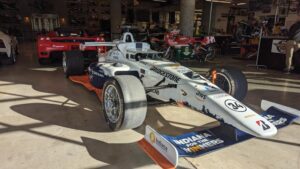When engineering meets AI: international award for the Robotics Center and its advances in autonomous navigation


The award-winning paper proposes an innovative solution to improve “dead reckoning”, a navigation technique based on inertial and odometry information to determine the movement of a wheeled vehicle. The information is provided by IMU (Inertial Measurement Unit) sensors, an instrument used in navigation capable of integrating a vehicle’s movements to estimate its orientation, speed and position. These are combined with odometers to calculate a vehicle’s trajectory from its last known position.
Historically used in the aeronautical and marine industries, inertial navigation can now be used in the automotive sector, particularly with the advent of autonomous vehicles. However, as sensors are less expensive than those used in aeronautics, the estimate tends to deviate rapidly from the actual trajectory. To overcome these obstacles, the team turned to artificial intelligence, but in a targeted way: AI is employed solely to determine at any given moment the degree of confidence that inertial navigation can have in wheel-turn measurements.
In this way, AI can compensate for the shortcomings of traditional methods. Rather than completely replacing tried-and-tested navigation techniques, AI is used to improve aspects that conventional techniques struggle to address, particularly in unmodeled or unpredictable conditions (e.g. wheel slippage).
One of the most remarkable features of this work is that it manages to rival methods based on camera vision. Indeed, the experimental results obtained show a trajectory error of less than 1%, making it a serious alternative to camera-based systems. This opens up new prospects for autonomous vehicles, in particular for taking over from vision in the event of a problem (camera fault, lack of brightness, snow-covered road).

This diagram from the article shows the different coordinate systems used in the study. The aim is to find the trajectory of the car (in blue) at any given moment, without using vision.
The prize-winning article is in line with Mines Paris – PSL’s policy of promoting partnerships between research and the business world. Indeed, it is a joint project with Safran, a specialist in navigation systems and one of the world leaders in the sector, and a perfect illustration of the multidisciplinary approach needed to advance autonomous navigation.
Martin Brossard, who wrote this article during his thesis at CAOR, now works for Helsing, a company specializing in artificial intelligence. Axel Barrau, a former associate researcher at CAOR, co-director of the thesis and an engineer at Safran at the time of writing, is today Chief Technology Officer of the startup Offroad, whose high-precision automatic mapping systems are enabling new management of public space. Their contributions, alongside those of Silvère Bonnabel, demonstrate the richness and diversity of the talent trained at Mines Paris – PSL.

Autonomous racing car from Auburn University, sponsored by Safran Electronics & Defense
Since its creation, CAOR has played a pioneering role in the field of intelligent vehicles. This avant-garde vision is largely due to Claude Laurgeau, professor, roboticist and founder of the center in 1988, which he headed until February 2008. As early as the 1990s, Claude Laurgeau was already anticipating current technological developments. His book, Le siècle de la voiture intelligente, published by Presses des Mines, bears witness to this anticipation of future developments in autonomous transport.
The IEEE T-IV Best Paper Award, received a few days ago, crowns several years’ research, evaluated on the basis of originality, citations, impact and importance for the scientific community. The IEEE T-IV, an international journal with a high profile as evidenced by its impact factor of 14, publishes numerous articles, sorted by review committees. This recognition is not only an individual reward, but also confirms the CAOR’s privileged international position in intelligent vehicle research, one of the laboratory’s long-standing areas of research.
This is not the first time that Silvère Bonnabel has been honored for his contributions. In 2020, he already received a similar award for his work in the field of automation, a branch of robotics at the heart of CAOR’s research, as well as the Prix Européen de l’Automatique in 2021, and the IMT-Académie des Sciences prize in 2022.
The prize rewards not only the originality of the research, but also its potential impact in the real world. At a time when autonomous vehicles are playing an increasingly important role in the mobility projects of the future, this technological breakthrough opens the way to new concrete applications.
Read the award-winning article

Axel Barrau, founder and technical director of OFFROAD

Martin Brossard, AI research engineer at Helsing

Led by ARMINES and Mines Paris – PSL under the coordination of the Centre Observation, Impacts, Énergie (O.I.E.) and with the support of the Centre de...